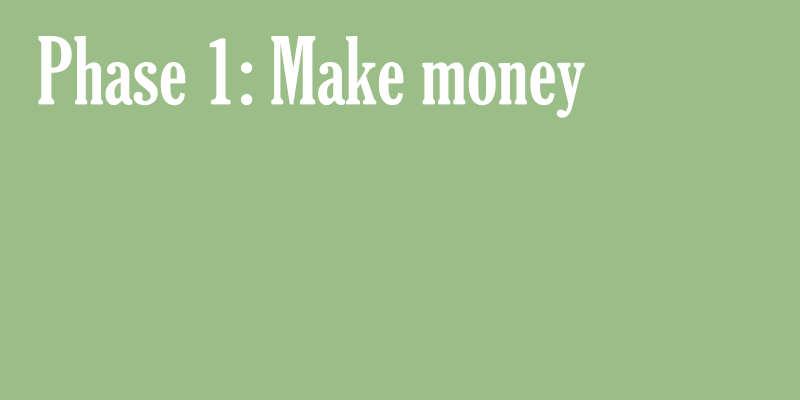How To Freelance Without The Financial Headache

by Haele Wolfe
The financial side of striking out on your own can be initially overwhelming: One of the hallmarks of freelancing is the dilemma of the feast or famine workflow. You can fully expect months of freelancing to leave your pockets flush with cash, while other times you’ll wonder if anyone will ever hire you again. How does anyone make this kind of unsteady cash flow into a viable career? What about retirement or taxes that would ordinarily be covered by working for a company?
Luckily, there are answers to all of these questions—and personal finance for freelancers doesn’t have to give you anxiety. Here’s the most effective personal finance tips for freelancers to help you manage your money without the stress.
Start with a Budget

First things first: you need a budget. Whether you use an excel spreadsheet, app, or a notebook and paper, first start by calculating your expenses. J.R. Duren, a personal finance expert at product review platform HighYa, suggests going back through bank and credit card statements and writing down how much was spent in non-necessary categories—like eating out, going to movies, hobbies—over the past three months. Calculate the average spending in each of these categories per month so that you can see where to cut back if necessary (you might be surprised where you’re spending your money!). Take twenty percent off the top of whatever categories could use a little trimming, then add up one month’s expenses, plus your necessary, static payments (like rent and utilities). The resulting number, plus at least fifteen percent (more on this in a bit), is how much you need to make every month in order to cover the expense of quarterly taxes, personal needs, and a little bit of room for savings or emergencies. Ideally, you’ll be earning more than fifteen percent of your calculated budget—but it’s smart to plan lean. Now you have your necessary income for each month. (If making a budget seems overwhelming, you can rely on apps. The experts I spoke to namechecked Daily Budget, Goodbudget, and Mint.)
Now, you’ll want to set up your client roster to ensure you can hit that number every month—and if you can’t, set up some stop gaps. As I learned from my own days as a freelancer, anchor clients—or clients who want to work more consistently with you—will form the cornerstone of your freelancing business. While your business grows, make a point to have conversations with current clients about the possibility of long-term work and incentivize them by telling them that you want to devote more hours to their contracts in exchange for some job security. Having some consistent work will provide another backup for more sparse work months, and will help you cut back on stress.
When anchor clients fail, drop off the map, or simply don’t pan out, you need a game plan to avoid feast or famine. Marques Lang, a CFP at Paradigm Consulting and Coaching, advises that freelancers commit to frugality early on. Put away extra savings each month in a separate account so that during lean months, you can still pay yourself regular income out of this account. Make sure to add any higher than estimated income into this savings account as well. Ideally, you want about three months worth of income saved there at all times.
Save Extra for Taxes

Without taxes coming out of every check you receive, you’re fully responsible for keeping track of what you owe the government. Shelby Rogers, a Content Marketing Strategist at DigitalUs, says that saving for taxes is especially important for new freelancers because freelancers often forget to budget for the expense—especially when it comes to quarterly taxes. The price of forgetting can be steep.
Penalties for neglecting to pay your taxes increase as time passes from when they were supposed to be filed, and begin at a charge of 5 percent of the unpaid tax required to be reported. You can accrue up to $205 (plus an adjustment for inflation) on unpaid taxes, and be charged each month that a return is late.
Rogers says that it took her three and a half years to nail down how to prep for taxes as a freelancer. Her method of dealing with the expense is all about self-control. She suggests taking forty percent of every payment from a client and putting it aside into a separate savings account—especially if you’re unsure of your willpower to leave that money alone.
When it’s time for tax season, these savings will both help pay the IRS and make you feel better about the amount that is due (because it will correlate directly with what you made). Remember that you want to over-budget your first year—not under-budget. After a year of paying taxes, you can better calibrate how much you have to set aside each month moving forward.
Make a Plan for Retirement and Savings

While working without a traditional company to back you up with a benefits package might be daunting, the good news is that there’s no reason for freelancers to fear they’ll be working forever without retirement options. There are plenty of paths to choose from—independent contractors have the same options as small business owners and can pick from options such as a solo 401(k), SEP IRA (Simplified Employee Pension Individual Retirement Account), regular IRA, or Roth IRA, and can make all the necessary adjustments to decrease their tax liability and increase their long-term growth.
The solo 401(k) program has the same contribution limit as regular 401(k) programs ($18,500 in 2018), but with the option of a profit sharing contribution since freelancers are both the employee and employer.
An Individual Retirement Account (IRA) is a savings account that offers benefits in the form of tax cuts as you save. With a traditional IRA and a Roth IRA, individuals can’t put away more than $5,500 per year. A Roth IRA is a retirement account funded with post-tax income. With a traditional IRA, there are tax-deduction perks on the money you’re putting away. A Roth IRA lacks these perks, but all the money you put away can be accessed at any time over age 59 ½ tax-free and penalty-free.
With a SEP IRA, freelancers can add themselves as both employee and employer to the plan and set up an automatic payment that is taken out of their paychecks and goes directly into a retirement account. It’s simpler than a solo 401(k) since it doesn’t require you to set up profit sharing.
So there you have it, managing your freelance business doesn’t have to be scary or difficult. After you lock down the skills to pay the bills, spend some time on planning out how you want your business to look, run, and fit in with the other parts of your life. With the right budgeting, apps, and tools, you’ll be enjoying the fruits of a successful career change in no time!





